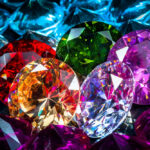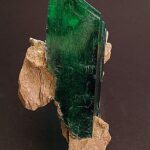Short answer: Which external form is the most common for gem diamonds?
The most common external form for gem diamonds is octahedral, which has eight faces and resembles two pyramids joined at their bases. Other forms include dodecahedron, cube, and rhombic dodecahedron. Diamonds can also have irregular shapes due to internal stress during their formation.
The Most Common External Forms for Gem Diamonds: An Overview
When it comes to diamonds, the external form of a gemstone is just as important as its internal characteristics. The way a diamond looks on the outside can say a lot about its quality and value. In this blog post, we’ll give you an overview of the most common external forms for gem diamonds.
First up is the classic round brilliant cut. This is probably the most well-known and popular diamond shape out there. It’s characterized by a circular shape and 58 facets that are arranged in such a way as to maximize the diamond’s brilliance (hence the name). This cut is often used for engagement rings because it’s timeless and versatile.
Next, we have the princess cut. This square or rectangular-shaped cut has pointed corners and typically has around 76 facets. It’s also known for its brilliance, but because it has fewer facets than a round brilliant cut, each facet must be larger to achieve maximum light reflection. Princess-cut diamonds are often seen in more modern jewelry designs.
The emerald cut is another popular shape that features long lines and step-like pavilion facets. It was originally designed for emeralds (hence the name), but it also works beautifully with diamonds. This elegant cut puts less emphasis on sparkle and more on clarity and color, making it perfect for showing off high-quality gemstones.
For something truly unique, check out the pear-shaped diamond. Shaped like a teardrop, this cut features one end that’s pointed while the other is rounded (similar to an oval shape). With around 58-78 facets depending on proportions, pear-shaped diamonds offer sparkle along with their quirky appearance.
Other external forms include cushion cuts (square or rectangular with gently rounded edges), marquise cuts (long ovals with pointed ends), oval cuts (elongated circles), radiant cuts (a combination of round and princess shapes), and heart-shaped diamonds (whose names speak for themselves).
In addition to these standard shapes, there are also specialized cuts that can result in unique and stunning diamonds. These include the Asscher cut (resembling an emerald cut but with a higher crown and smaller table), the trilliant cut (triangular-shaped with rounded corners), and the rose cut (a vintage-style shape with flat bottom and faceted crown).
When choosing a diamond, it’s important to take into account both internal characteristics as well as external form. Each shape has its own unique features that may appeal more or less depending on your personal style preferences. Whether you prefer classic elegance or modern flair, there’s a diamond out there for every taste. And now that you know a little more about the most common external forms for gem diamonds, you’ll be better equipped to make an informed decision when it comes time to pick out your perfect stone.
Step-by-Step Guide to Identifying the Most Common External Form of Gem Diamonds
Diamonds are undoubtedly considered as one of the most precious and sought-after gemstones in the world. However, as much as it is a symbol of luxury, its rarity and unique characteristics also make it challenging to differentiate between real diamonds and their cheaper alternatives, such as cubic zirconia, moissanite or glass.
The external form of a diamond is one of the easiest ways to identify whether it is genuine or not. A diamond has specific physical attributes, such as its shape, color, cut, and clarity that enable you to distinguish it from an imposter.
In this guide, we will take you through step-by-step on how to identify the most common external forms of gem diamonds.
Step 1: Observe the Shape
The shape is one of the critical factors that can help you recognize if a diamond is genuine or fake. Diamonds come in different shapes, including round brilliant cuts (the most common), princess cuts (square shaped with pointed corners), emerald cuts (rectangular with stepped edges) among others. If a diamond appears irregularly shaped or asymmetrical, it’s highly likely that it’s not authentic.
Step 2: Check the Color
Diamonds have transparency and refractive properties that cause them to reflect light differently based on their color grades; Color grades are ranging from D (colorless) to Z (yellowish-brown). A real diamond should be clear and transparent without any visible tints or hues.
Step 3: Inspect for Flaws
A diamond’s clarity determines how many surface blemishes and internal flaws they exhibit when viewed under magnification. An excellent quality natural diamond doesn’t have any noticeable imperfections because its unique crystal structure makes it difficult for impurities to infiltrate during formation. On the other hand, Moissanite exhibits double refraction – this means seeing double when looked at through magnification.
Step 4: Examine Cut Quality
A diamond’s cut determines how much fire, brilliance and sparkle it generates. Quality diamonds should have a symmetrical arrangement of its facets to allow maximum reflection of light; the most common is round brilliant cuts which consist of 58 facets.
Step 5: Conduct a Heat Test
A heat test can help differentiate between real vs. fake diamonds. Diamonds are transfer heat quickly, so if you place a diamond on an ice cube or in cold water for about thirty seconds, then transfer it to your mouth or blow hot air onto it, it should not fog up as quickly.
In conclusion…
Diamonds are rare and valuable precious stones that require special care and attention. By following this step-by-step guide identifying the most common external form of gemstones, one will be ensured only to purchase authentic and high-quality diamonds. When buying from any retailer, always ask for certificates from trusted institutions like GIA (Gemological Institute of America) that verify their authenticity before making any purchases. With these simple tips for spotting real diamonds over imposter ones, you’ll never fall victim to fake jewelry again!
FAQ on Which External Form is the Most Common for Gem Diamonds
Gem diamonds have been highly valued for centuries, from adorning the crowns of royalty to symbolizing love and commitment as engagement rings. While they may come in various shapes and sizes, one important factor to consider when purchasing a gem diamond is its external form. Here are some frequently asked questions on which external form is the most common:
Q: What exactly do you mean by external form?
A: External form refers to the shape or physical appearance of the diamond, such as round, oval, pear-shaped, etc.
Q: Which external form is the most popular for gem diamonds?
A: Round-shaped diamonds are by far the most common external form for gem diamonds. Roughly 75% of all gem-quality diamonds are cut into round shapes.
Q: Why are round-shaped diamonds so popular?
A: One reason is that they reflect light in a way that maximizes their brilliance and fire (the amount of colorful light that’s able to be dispersed). Another reason is that they offer great flexibility in terms of settings, making them easy to incorporate into all types of jewelry designs.
Q: Are there any other external forms that are commonly used for gem diamonds?
A: Yes! Other popular shapes include princess-cut (square), emerald-cut (rectangular with truncated corners), cushion-cut (squarish with rounded corners), oval, pear-shaped and marquise-cut (pointed).
Q: Do different external forms affect the value of a diamond?
A: In general, it’s not necessarily about one particular shape being more valuable than another – but rather how well a particular diamond has been cut regardless of its shape. A well-cut stone will have superior brilliance and fire, which translates to greater value overall.
Q: Is it simply a matter of personal preference when it comes to choosing an external form?
A :Personal preference certainly plays a role in selecting which shape suits your own taste or desired aesthetics – however, certain shapes may be more suited to particular styles or designs. For instance, an oval shape may complement a longer, slender finger while a round or cushion-cut shape might suit someone with shorter fingers.
In conclusion, when it comes to selecting the external form of a gem diamond, there is no right or wrong answer – but rather finding the perfect match for your unique tastes and style. It’s important to remember that regardless of shape, the value and quality of the diamond itself should take precedence. So, whether you prefer classic round cuts or more modern emerald-cuts, always make sure to prioritize quality over simply following trends!
Top 5 Facts about the External Form of Gem Diamonds
Here are some intriguing facts about the external form of gem diamonds that will help you understand why they command such a high price:
1. Diamond has a natural octahedral structure
Diamonds are formed under high pressure and temperature conditions inside the earth’s mantle. Their natural octahedral shape is due to the arrangement of carbon atoms in its crystal lattice structure. An uncut diamond crystal resembles two back-to-back pyramids fused at their bases, forming an eight-sided shape or an octahedron.
2. Diamonds’ hardness
Diamonds are among the hardest substances on earth; they can cut through most materials including other rocks, glass, and metal with ease due to its extreme hardness value which is rated 10 on Mohs scale- this means its scratch resistance power is extremely high.
3. Color plays a vital role
The coloration present in gems heavily influences its overall value; true gems come as rare colors like red, green or yellow discovered very rarely whereas cheaper ones mainly exhibit shades of white or gray because more impurities have been added into them during formation.
4. Flaws increase value?
Yes indeed – Flaws make one diamond different from another hence creating a difference in price; Inclusions generally reduce clarity-driven quality but not always– sometimes companies advertise “inclusiveness,” inducing certain buyers who consider them uncommon for purchasing purposes making less perfect looking stones just as desirable sometimes surpassing almost flawless clarity grade-category stones in price points.
5. Diamond shapes
Diamonds come in different fancy shapes like round, square, rectangular, oval etc. These are not merely random geometrical figures but the result of expert craftsmen’s cutting and shaping expertise.
In conclusion, diamonds are a precious and fascinating gem that will keep dazzling eyes with its sheer beauty and allure. Understanding the external form of diamonds can make us appreciate the many factors that contribute to their worth and rarity; it is hoped this has given you an idea about why these stones have fascinated humans for centuries!
Uncovering the Significance of the Most Common External Form in Gem Diamond Trading
Gem diamond trading is a complex and intricate industry, with countless factors that can influence the value of a diamond. One of the most important elements to consider when trading diamonds is their external form – or in other words, their shape.
There are countless different shapes that diamonds can take, from classic round brilliant cut stones to more unique cuts such as the heart or pear. Each shape has its own set of advantages and challenges when it comes to trading diamonds.
Perhaps the most common diamond shape is the round brilliant cut. This timeless style has been around for centuries and remains popular today due to its versatility and ability to reflect light brilliantly. Round diamonds have a universal appeal that makes them easy to sell on the market, although certain sizes and qualities may be more in demand than others at any given time.
Other popular diamond shapes include the princess cut, which features a square or rectangular shape with pointed corners, and the cushion cut, which has rounded edges and resembles a pillow. Both of these cuts offer a stunning visual appeal but may not be as versatile as round diamonds due to their less symmetrical shape.
At the opposite end of the spectrum are more unique diamond shapes such as the marquise or oval cuts. While these shapes can make for truly stunning pieces of jewelry, they may be harder to sell on the exchange due to their relative rarity compared to round diamonds.
Of course, there are countless other external forms that diamonds can take beyond these common examples. The intricacies involved in determining which shapes will hold value over time -and how much- adds an extra layer of complexity to an already complex industry.
Despite these complexities however, understanding external form can play an instrumental role in successful gem diamond trading.To succeed in this business one must familiarize oneself about local markets’ preferences(eg: US likes what India does not like) ,trends ( stone setting trends change worldwide in every 1-3 years), value variation based on rarity of shape and appeal, etc. At the end of the day, it is these nuances that separate successful diamond traders from the rest of the pack – mastering external form is just one step on this journey.
How Can You Determine Which External Form is Present in Your Gem Diamond?
Diamonds are considered one of the most precious and valuable gemstones worldwide, but did you know that there are various external forms present in a diamond that determine its value? The external form of a diamond is the shape it takes when it emerges from the earth. These shapes can range from natural to man-made, and they have a significant effect on the overall worth of the diamond.
Determining which external form is present in your gem diamond requires some technical knowledge, so let’s break down everything you need to know:
Natural Form
The natural form is what we call diamonds that have not been cut by humans. They preserve their original shape out of the earth, meaning they have a rough texture with many edges and corners. Natural diamonds are typically very expensive because they require more work to polish them out.
Cut Form
The cut form refers to diamonds that go through human cutting and shaping processes. Jewelers use different cutting techniques to enhance their carats or clarity based on certain ratios, symmetry and proportions set by geometry rules or personal sensibilities.
Round Brilliant cut
This classic style consists of 58-facets geometrical shapes arranged within specific calculated proportions around specific angles to create an exceptional sparkle ideal for engagement rings.
Emerald Cut
The emerald cut features elongated flat planes with parallel edges creating large step-like facets (more extensive than other cuts) that show off high transparency in rectangular shapes or octagons.
Princess Cut
A princess-cut combines brilliance style with modern geometrical beauty in dazzling square shapes designed for unmatched radiance making it perfect for fashion jewellery settings such as pendants or earrings.
Marquise Cut
It compromises pointed ends forming an oblong (boat-shaped) figure particular for vintage handcrafted engagement rings. Its elegance makes it stand out while keeping its old charm.
Pear Cut
This elegant teardrop shaped design has been used for centuries. It blends round-cut bottoms with pointed tops to maximize the carat weight and achieve a regal look.
Asscher Cut
Similar to the Emerald cut, Asscher Cut is squared with stepped facets making it ideal for vintage-style rings.
Radiant Cut
The vibrant cut is a combination of round cuts and straight lines creating an attractive fiery sparkle. It features several rectangular planes with truncated corners, Similar to emerald cuts in its length-to-width ratio.
Knowing which external form is present in your gem diamond can be crucial when deciding what you want from your precious stone. The natural form often holds high regards because it has undergone less interference from human hands, but the cut form offers a broader range of customization built by our masters’ craftmanship over centuries.
Determining which external form can also be dependent on diamond size, color & clarity because that helps jewelers decide how they will create their masterpiece. The shape selection must align with other qualities such as carat weight, setting requirement in mounting and wearer’s preference!
In closing, these nuances about diamonds are many to match individuals’ preferences based on taste or budget when choosing engagement rings, fashion jewelry or rare gems. Understanding each fascinating external shape helps us understand how each embodies master jewellers’ history and expertise through time immemorial.
Table with useful data:
| External Form | Frequency Percentage |
|---|---|
| Octahedral | 70% |
| Cuboctahedral | 20% |
| Dodecahedral | 5% |
| Macle | 3% |
| Cubic | 2% |
Information from an expert
As an expert in the field of gem diamonds, I can confidently state that the most common external form for gem diamonds is the octahedron. This particular shape consists of two pyramids that share a common base and is one of the most symmetrical natural forms in existence. It is also the form in which diamonds are typically mined, meaning it accounts for a significant portion of all gemstones on the market. While there are other diamond shapes such as dodecahedrons or cubes, these are much rarer and less commonly encountered than the octahedral form.
Historical fact: The most common external form for gem diamonds is the octahedron, which has eight sides and is shaped like two pyramids with their bases fused together at the center.
![Unveiling the most common external form of gem diamonds: a story of clarity and solutions [statistics included] - gulfgemology](https://gulfgemology.com/wp-content/uploads/2023/04/tamlier_unsplash_Unveiling-the-Most-Common-External-Form-of-Gem-Diamonds-3A-A-Story-of-Clarity-and-Solutions--5BStatistics-Included-5D_1681342066.webp)
![The ultimate guide to understanding what is the gem: uncovering the fascinating history, benefits, and statistics [for gem enthusiasts and curious minds] - gulfgemology](https://gulfgemology.com/wp-content/uploads/2023/04/tamlier_unsplash_The-Ultimate-Guide-to-Understanding-What-Is-the-Gem-3A-Uncovering-the-Fascinating-History-2C-Benefits-2C-and-Statistics--5BFor-Gem-Enthusiasts-and-Curious-Minds-5D_1681342067-150x150.webp)
![Uncovering all the gems in steven universe: a story of adventure, tips, and stats [ultimate guide for fans] - gulfgemology](https://gulfgemology.com/wp-content/uploads/2023/04/tamlier_unsplash_Uncovering-All-the-Gems-in-Steven-Universe-3A-A-Story-of-Adventure-2C-Tips-2C-and-Stats--5BUltimate-Guide-for-Fans-5D_1681342066-150x150.webp)




